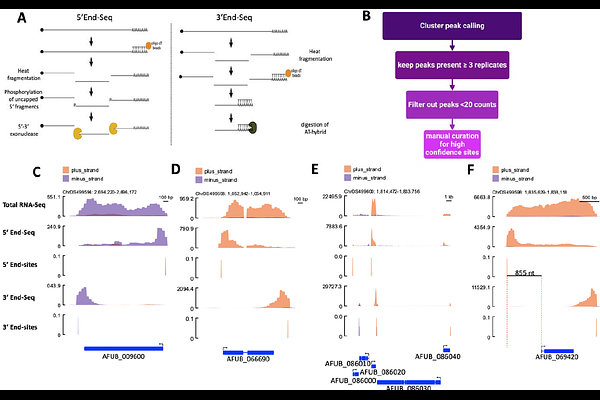Comprehensive mapping of the 5' and 3' untranslated regions of Aspergillus fumigatus reveals new insights into gene regulation

Comprehensive mapping of the 5' and 3' untranslated regions of Aspergillus fumigatus reveals new insights into gene regulation
Schrettenbrunner, L.; Maufrais, C.; Janbon, G.; Wallace, E.; Blango, M. G.
AbstractIn the twenty years since the first genome sequencing of Aspergillus fumigatus, the field has seen an explosion in both the number of sequenced genomes and our molecular understanding of this ubiquitous human fungal pathogen. Despite an improved knowledge of the A. fumigatus genome, we still know little about the transcriptome, with key regulatory sequences like the untranslated regions of mRNA based only on in silico predictions and bulk-RNA-seq. Here, we provide an improved description of 5\' and 3\' untranslated regions of A. fumigatus poly(A)-enriched RNA through experimental mapping of transcription start sites and polyadenylation sites using 5\' and 3\' End-Seq. We assigned high-quality 5\' ends to 2,747 genes (average length 126 nt), 3\' ends to 7,079 genes (average length 268 nt), and improved our understanding of the regulatory landscape of A. fumigatus gene expression. We leveraged the refined 5\' UTRs to identify upstream open reading frames and binding sites for important RNA binding proteins like the translational regulator Ssd1 and the 3\' UTRs to define binding sites for PUF proteins known to contribute to mRNA localization and regulation. Although a single isoform typically dominated expression, we observed 148 instances of alternative start sites and 1,675 alternative stop sites. Interestingly, we detected multiple examples of premature transcriptional termination, including the first evidence for promoter-proximal premature transcriptional termination in a member of the Eurotiomycetes. Ultimately, we provide a resource to the Aspergillus community and an accurate starting point for unravelling the complexities of gene regulation in an important human pathogen.